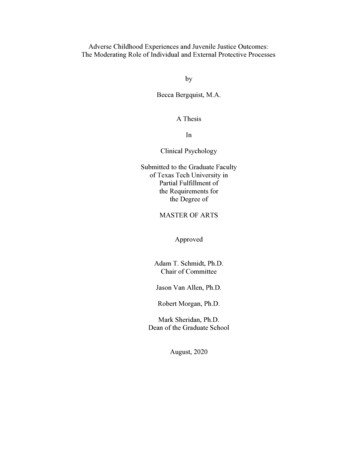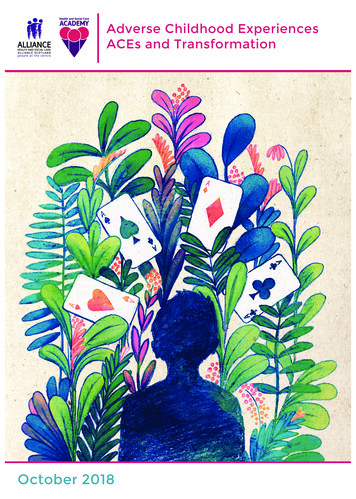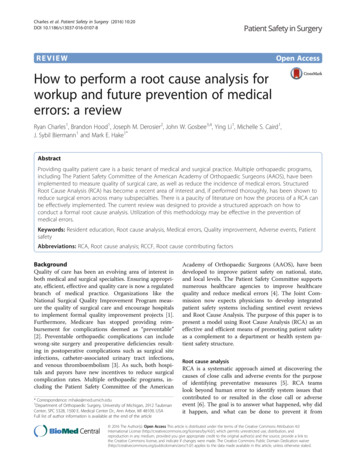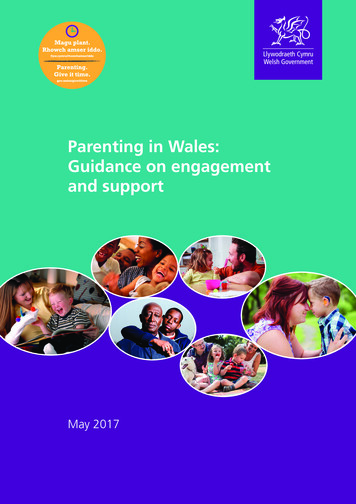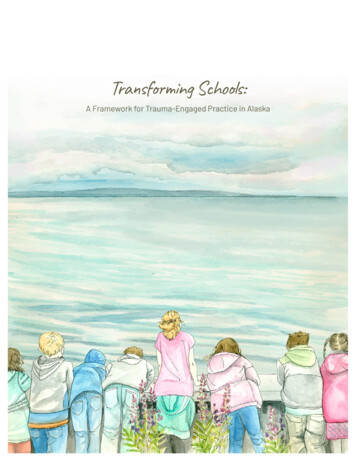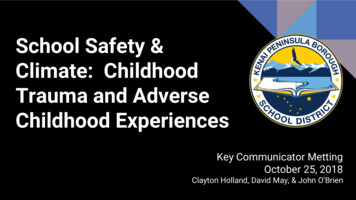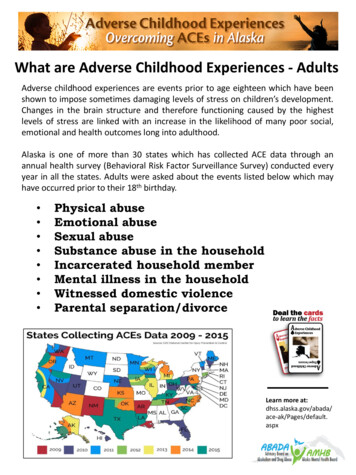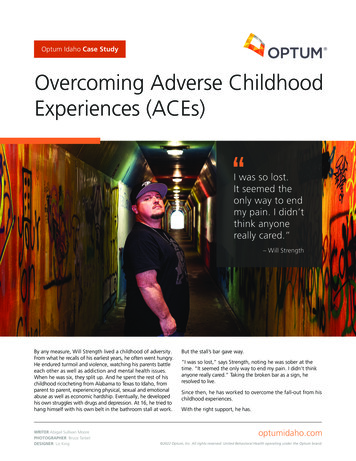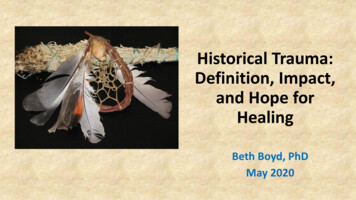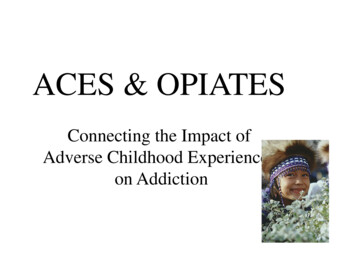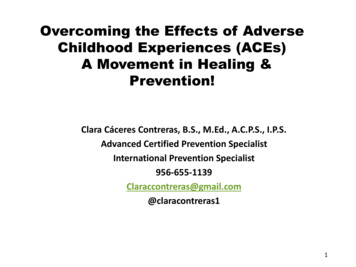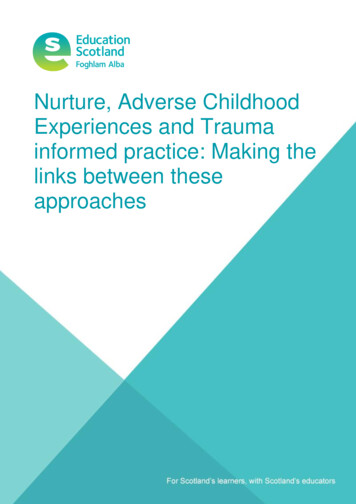
Transcription
Nurture, Adverse ChildhoodExperiences and Traumainformed practice: Making thelinks between theseapproaches
Introduction/contextScottish education has a key focus on wellbeing and relationship-based approaches to support childrenand young people. An understanding of how early experiences impact on children and young people’sbehaviour and the importance of relationships in shaping later outcomes is also the foundation whichunderpins much of the Scottish policy landscape and curriculum. Getting it Right for Every Child(GIRFEC) recognises that children and young people will have different experiences in their lives, butthat every child and young person has the right to expect appropriate support from adults to allow themto grow and develop and reach their full potential. This is now enshrined in legislation in the Children andYoung Person’s (Scotland) Act (2014).The Adverse Childhood Experiences (ACEs) studyi which was initially published in the USA and laterreplicated in both Englandii and Wales,iii has recently had a renewed focus both internationally and withinScotland, in part due to the release of the film ‘Resilience: The Biology of Stress and the Science ofHope. One of the core messages which has been emphasised within this research is the correlationbetween the number of adverse childhood experiences an individual goes through and poor health andsocial outcomes in adulthood. It has long been recognised that stressful events occurring in childhoodcan impact profoundly on children and young people’s development and outcomes including the capacityto learn and participate in school life. The increased interest in ACEs provides an opportunity to re-focuson the importance of childhood development. One of the key theoretical frameworks which emphasisesthe importance of early experiences and particularly the bond that an infant has with a caregiver isattachment theory.iv Attachment theory forms a core part of a nurturing approach. At the heart of anurturing approach is a focus on wellbeing and relationships and a drive to support the growth anddevelopment of children and young people particularly those who may have experienced early adversityor trauma. Trauma informed approaches aim to promote an understanding of adversity and traumaamongst those working with children and young people and the wider population.This paper will bring together the key components of nurturing, ACEs and trauma informed approachesbefore considering what commonalities and good practice exists across all approaches. It will alsoexplore some of the challenges of embedding these approaches within an educational context. Thispaper is intended mainly for education practitioners however it may also be useful for a wider audience.A nurturing approachA nurturing approach can encompass both targeted support, eg. Nurture Groups and universal supportas in a whole school approach. Nurture Groups were initially developed as an approach to supportingchildren who were believed to have missed some key early experiences which impacted on their abilityto settle and respond to school. They were created by Marjory Boxall, an Educational Psychologist, inthe 1960s in an inner city London borough as a means of bridging the gap between school and homeand to help recreate these missed early experiences through nurturing and supportive relationships.Over time, the original Nurture Group concept has extended into a whole school approach whichpromotes nurturing and supportive relationships.A nurturing approach is based largely on the theory of attachment; an understanding of the impact ofearly adversity and how this can lead to ‘toxic stress’. Whilst a nurturing approach is based on anunderstanding of children’s development, it also takes account of the current advances in neuroscienceand brain development. The theory of attachment originally stems from work by John Bowlby in the1950s and later by Mary Ainsworth in the 1960s. Children display proximity seeking behaviours in orderto get the attention of their caregiver and the caregivers response in those early interactions results inthe child developing an attachment style that is either secure or insecure. This attachment relationship isimportant for future long-term outcomes where secure attachment is viewed as a protective factor whichcan enhance social and emotional well-being and insecure attachment is seen as a risk factor in relationto well-being. The key importance of attachment with adults has been well documented as a foundationfor building resilience in young people and supporting their ability to engage in learning experiences.v vi
A further key feature of the nurturing approach is the focus on the 6 Nurturing Principlesvii which areoutlined below.Learning isunderstooddevelopmentallyTransitions areimportant inchildren's livesEnvironmentoffers a safebaseAll behaviour iscommunicationNurture isimportant forwellbeingLanguage is avital means ofcommunicationWhole school and targeted approaches use these principles to guide practice. For example, in anurturing classroom or nurture group, children are encouraged to create strong bonds that allow them tofeel safe and explore their wider environment much as they would in a secure attachment relationship.Some of the key themesviii which are outlined in a nurturing approach are highlighted below.Research on Nurture Groups has demonstrated benefits in social and emotional skills as well asattainment.ix x A range of evidence has also demonstrated the importance of some of the key features ofa whole school nurturing approach, e.g. attachment to teachers has been shown to link strongly tobehavior, attainment and other positive outcomes.xi Consequently both Nurture Groups and nurturingapproaches have grown greatly in Scotland in the last twenty years and there are a number of key policydocuments which advocate these approaches.xii xiii Research has also demonstrated that whole schoolapproaches which support professional learning and policy development have a greater impact onwellbeing outcomes.xivEducation Scotland has also developed a resource entitled ‘Applying Nurture as a whole schoolapproach: which is a framework to support the self-evaluation of nurturing approaches in schools andearly learning and childcare settings.
Adverse Childhood Experiences (ACEs)The original ACEs study carried out between 1995 and 1997 surveyed 17,000 adults in the US askingthem to complete a set of questions about adverse childhood experiences and current health status andbehaviours. An adverse childhood experience is a term given to describe all types of abuse, neglect andother traumatic experiences that happen to individuals under the age of 18 years. Ten adversechildhood experiences were identified. In the original US study traumatic events were categorised intoabuse, neglect and household dysfunction. It has since been recognised that a number of adverse,potentially traumatic events were not included in the original ACES study including poverty, bereavementand bullying.Used with permission from the Scottish GovernmentResults from this study indicated that ACEs are common, with almost two-thirds of the U.S studyparticipants reporting at least one ACE and more than 1 in 5 reporting three or more ACEs. Those with 4or more ACEs were at greater risk of long term effects on health harming behaviours which leads topoorer outcomes in later life.In the UK there have been two ACE studies carried out in England and Wales both demonstrating stronglinks between early adverse experiences and poor health and social outcomes in adulthood. While therehas not been a Scottish ACE survey, a Scottish Public Health Network report, suggested thatprevalence rates are likely to be similar to those reported in these studies.Used with permission from the Centers for Disease Control and Prevention
'Polishing the Diamonds' Addressing Adverse Childhood Experiences in Scotland provides an overviewof ACEs and inequality, whilst Tackling the attainment gap by preventing and responding to AdverseChildhood Experiences (ACEs) provides further guidance for educators in tackling the attainment gap.There is also an increasing recognition of the links between adverse childhood experiences, inequalityand later offending behaviour as outlined in ‘Reducing offending, reducing inequality’. xvThese documents xvi xvii highlight the links between ACEs and health inequalities and the need to build onstrategies that increase resilience in all children and young people by recognising the importance oftargeting specific social and emotional skill development. The importance of one stable adult relationshipwhich often acts as a protective buffer and allows children and young people to develop skills needed tocope with adverse life experiences is also recognised.One of the key messages that has arisen in discussion about ACEs within education and beyond is theneed to use ACEs awareness to guide practice and link it with existing frameworks. The Welsh ACEsresearch has also recently highlighted sources of resiliencexviii and how they can mitigate against theinfluence of ACEs.Trauma Informed practiceGiven the growing awareness of the prevalence of adverse and traumatic experiences in childhood andan understanding of the impact of these, interest is growing in what is often termed trauma informedpractice. The framework ‘Transforming Psychological Trauma’xix indicates that this is everyone’sbusiness and highlights the need to increase the understanding of trauma and its impact throughsupporting the development of skills and knowledge in the broad Scottish workforce. It also recognisesthe correlation between trauma and poorer outcomes which may be caused by the direct impact of thetrauma, the impact of the trauma on a person’s coping response or the impact of the trauma on aperson’s relationships with others.A response to adverse experiences will be impacted by both individual factors (such as previousexperiences, poverty, developmental level, presence of a disability) and experiential factors (chronic orsingle event, nature of event, availability of support, severity, physical proximity, presence of stigma,availability and quality of interventions). Importantly, what makes an experience traumatic is theindividual’s reaction to the event rather than the event itself. The terminology around different types oftrauma can often be complex and overlapping. The diagram below provides an illustration of whatexperiences might constitute trauma.Copyright 2017. NHS Education Scotland. Used with permission from NHS Education Scotland
Whilst this illustrates examples of simple and complex trauma, the term developmental trauma may alsobe used in trauma informed practice. Developmental trauma describes how complex trauma can impacton children and young people and how their development can slow down or become impaired followinga traumatic event.The evidence base is emerging that trauma informed practice can support identification of need and leadto improved outcomes for those affected by trauma.xx xxi xxii Considering support through a traumainformed lens can contribute to a greater understanding of the reasons underlying some children’sdifficulties with relationships, learning and behaviour. A school ethos that embraces an understanding ofwhat has happened to an individual is far more likely to lead to supportive interventions that ultimatelyavoid exacerbating stress and trauma. The focus should be on relationships and promoting skills in selfregulation rather than on punitive approaches. Integrating trauma informed approaches into existingeducational practices can contribute to the achievement of positive outcomes for children and youngpeople.What are the commonalities between a nurturing approach, Adverse Childhood Experiences(ACEs) awareness and trauma informed practice in an educational context? All recognise the importance of early adverse experiences on later outcomesAll highlight the importance of practitioners having an understanding and awareness ofunderlying reasons for behaviourThey are psychologically informed and make use of research/evidence to inform practiceThere is an emphasis is on the importance of relationships to support the negative impact of earlyadversity.Early intervention is emphasised as a means of preventing and mitigating against later negativeoutcomesThere is a recognition that poor outcomes are not predetermined and can be reduced withappropriate support that builds resilience in people affected by trauma and adversityThe diagram below outlines some of these links from a nurturing perspective.
Potential benefits of a nurturing approach, Adverse Childhood Experiences (ACEs) awarenessand trauma informed practice in an educational context Increases practitioner knowledge and awareness of the impact of early experiences thusincreasing staff confidence about responding appropriately to children and young people’sneedsProvides a framework to develop understanding and support for children and young peopleCan help to develop a shared language for practitionersOriginates from evidence based practiceEncourages schools and early years and childcare settings and their wider communities tofocus on early intervention and preventionAcknowledges the key role that practitioners can have in improving life chances for childrenand young peopleHelps the wider school community (including children, staff, parents and carers) to developunderstanding about the potential impact of adversity and trauma on their own lives and thelives of others, thus aiding recoveryPotential challenges of a nurturing approach, Adverse Childhood Experiences (ACEs)awareness and trauma informed practice in an educational context There is a possibility that highlighting the potentially negative outcomes related to adverseexperiences can give an overly fatalistic view if not balanced with evidence on resilienceWhen approaches are implemented in isolation without making clear links with nationalframeworks and priorities such as Getting it Right for Every Child and the wellbeing agenda,there is the risk of the approach being unsustainable and fragmentedEach approach needs to balance understanding and awareness with a clear focus onappropriate intervention and support that leads to positive outcomes for children and youngpeople. Further evidence needs to be gathered as to the impact of each of these approaches ata whole school levelComplexity and confusion around language and terminology that is often usedWhat would good practice look like within a nurturing, ACEs aware and a trauma informededucational context? Safe, secure, flexible and caring environments where positive relationships are seen as beingfundamentalA whole school focus on wellbeing; social and emotional learning and the building of resilienceAn awareness amongst practitioners of the impact of adverse experiences and trauma across thewhole school community (including staff and parents/carers)Assessment and planning that has a focus on what has happened to an individual rather thanwhat is wrong with an individualIdentification of developmentally appropriate supports that promotes self-regulationA range of universal whole school approaches that enhance the wellbeing of all children andyoung people alongside targeted support that is proportionate and meets the needs of childrenand young peopleSenior Leadership Teams and practitioners who are reflective and supportive in their practice andrecognise the importance of the wellbeing needs across the school communityEstablishments are able to take forward many features of highly effective practice as outlined inHow Good is Our School? 4 (HGIOS?4), eg. All staff and partners model behaviour whichpromotes and supports the wellbeing of all.
What work has already been undertaken within education to take this agenda forward? Extensive professional learning has been undertaken which focuses on attachment theory andwhole school nurturing approaches and this has supported staff understanding of the importanceof relationships and how to use the six nurturing principles to support the needs of all childrenand young people but particularly those who have experienced adverse childhood experiencesApplying Nurture as a whole school approach is being used by many schools and early learningand childcare settings to support their self-evaluation of a nurturing approach but also to providea framework to support an awareness of the impact of adverse early experiences and ofdevelopmental traumaHow good is our school? 4 and How good is our early learning and childcare provides clearguidance for schools to develop a ‘learning environment that is built on positive, nurturing andappropriately challenging relationships which lead to high quality learning outcomes’.Schools and early learning and childcare settings have undergone professional learning whichhas helped them to recognise what is involved in a trauma informed approach and use this toshape how language is used in schools and to develop a deeper understanding of the needs ofchildren and young people and how to support themKey adult programmes have been established which links a key adult to a child or young personin order to provide them with a good attachment model which can mitigate against some of theirearly adversityMany schools have a focus on the language of emotion and have developed a range of activitiesthat helps children and young people to express how they feel and to ask for support when theyneed itEngagement in self-regulation coaching sessions which has enabled practitioners to explore whatwe mean by self-regulation and help children and young people to develop skills to help them inareas such as executive functioning and in emotional regulation, whilst recognising the key roleof the adult in co-regulationA large number of schools and local authorities have bought the license for ‘Resilience: theBiology of Stress and the Science of Hope’ and have shown the film extensively to educators andtheir partners and have followed this up with discussion forums to focus on the issues facingchildren and young people in their communities whilst exploring means of supporting their needsSchools and early learning and childcare settings are working closely with their partners withinthe local authority and the third sector to explore how they can meet the needs of the familieswithin their schools by offering a range of skill based activities and opportunities forparents/carers to meet and support each otherA number of national and local events have been held which allow educators and their partnersto get together to share good practice and discuss the best ways of supporting children andyoung people who have experienced adverse childhood experiences and traumaConclusionThe national movement around Adverse Childhood Experiences has helped to reinforce the messagethat children’s early experiences impact significantly on their later outcomes – a message that is alsoemphasised in a nurturing approach and trauma informed practice, and has been further developed bythe growing field of neuroscience. This renewed focus is welcome as it has moved the conversation onfor many from ‘what is wrong with this child’ to ‘what has happened to this child’. However, it is essentialthat those involved in education are able to see the links between this and approaches that are alreadyestablished within education such as child development, attachment theory and whole school nurturingapproaches. One of the important messages for educators is the idea that relationships can mitigateagainst negative outcomes - both within the home and community context and the school context.Learning how to cope with adversity is an important part of healthy childhood development. It is onlywhen stress is prolonged and occurs without the buffering effect of protective relationships, that it canlead to a stress response or reaction that can become more toxic over time. Consequently, schoolsneed to develop a relationship based approach to support the wellbeing of all young people, butparticularly those who have experienced adversity without these protective relationships. Getting it right
for every child emphasises the importance of wellbeing in Scottish schools and this focus provides a keymandate for taking forward the approaches discussed in this paper. ‘If relationships are where thingsdevelopmentally can go wrong, then relationships are where they are most likely to be put right.”xxiiiWe are at exciting and pivotal moment in our national conscience with regard to recognising the impactof early experiences on children and young people and it is essential that we capitalise on this toimprove outcomes for all children and young people but we can only do this through linking it to existingframeworks and good work already in place.
ReferencesiFelliti, V. J, Anda, R. F et al. (1998) Relationship of childhood abuse and household dysfunction to manyof the leading causes of death in adults. The Adverse Childhood Experiences (ACE) Study, Am J PrevMed, 14: 245-258iiBellis, M. A et al. (2014) National household survey of adverse childhood experiences and theirrelationship with resilience to health-harming behaviours in England, BMC Medicine, 12: .1186/1741-7015-12-72iiiBellis M.A et al. (2015) Welsh Adverse Childhood Experiences (ACE) Study - Adverse ChildhoodExperiences and their impact on health-harming behaviours in the Welsh adult population. Public HealthWales NHS 6/01/ACE-Report-FINAL-E.pdfivBowlby, J. (1977) The making and breaking of affectional bonds: I. Aetiology and psychopathology in thelight of attachment theory. The British Journal of Psychiatry, 130, 201-210.Bomber, L. (2007) Inside I’m Hurting: Practical Strategies for Supporting Children with AttachmentDifficulties in Schools, Worth Publishing LondonvviCentre on the Developing Child at Harvard University. (2015) Supportive relationships and active skillbuilding strengthen the foundations of resilience, Working Paper trengthenthe-foundations-of-resilience/viiLuca,S., Insley,K. and Buckland G. (2006) Nurture Group Principles and Curriculum Guidelines HelpingChildren to Achieve, The Nurture Group Networkwww.nurtureuk.orgviiiEducation Scotland (2017) Applying Nurture as a whole school approach: A framework to support theself-evaluation of nurturing approaches in schools and ELC t%20self-evaluationixReynolds S, McKay T, Kearney M. (2009) Nurture groups: A large scale controlled study of effects ondevelopment and academic attainment. British Journal of Special Education, 36: 204-212xMcKay T, Reynolds S, Kearney M. (2010) From attachment to attainment: The impact of nurture groupson academic achievement. Educational and Child Psychology, 27: 100-110xiBergin C & Bergin D. (2009) Attachment in the classroom. Educ Psychol Rev, 21: 141-170xiiScottish Government (2017) Included, Engaged and Involved Part 2: A positive approach to preventingand managing school /8877xiiiScottish Government (2013) Better relationships, better learning, better 7388/1xivWeare, K. (2015) What works in promoting social and emotional well-being and responding to mentalhealth problems in schools. Partnership for well-being and mental health in schools, Partnership for wellbeing and mental health in uploads/documents/Health wellbeing docs/ncb framework for promoting well-being and responding to mental health in schools.pdfxvNHS Health Scotland (2017) Reducing offending, reducing ons/reducing-offending-reducing-inequality
xviScottish Public Health Network (2016) Polishing the Diamonds: Addressing adverse childhoodexperiences in s/2016/06/2016 05 26-ACE-Report-Final-AF.pdfxviiNHS Health Scotland (2017) Tackling the attainment gap by preventing and responding to AdverseChildhood Experiences ponding-toadverse-childhood-experiencesxviiiPublic Health Wales (2018) Sources of resilience and their moderating relationships with harms fromadverse childhood ents/888/ACE%20&%20Resilience%20Report%20(Eng final2).pdfxix, NHS Education for Scotland (2017) Transforming Psychological Trauma: A Knowledge and SkillsFramework for the Scottish nationaltraumatrainingframework.pdfxxAustralian Childhood Foundation (2010) Making space for learning: Trauma informed practice in akingspaceforlearning-traumainschools.pdfxxiHodas G. R, (2006) Responding to childhood trauma: The promise and practice of trauma informed care.Pennsylvania Office of Mental Health and Substance Abuse Services, /uploads/2012/05/promise and practice of ti services by hodas.pdfxxii Overstreet S & Chafouleas S M.(2016) Introduction to the special issue, School Mental Health, Volume8, Issue 1: Fs12310-016-9184-1.pdfxxiiiHowe D. (2005) Child abuse and neglect: Attachment, development and intervention, Palgrove,Macmillan.
Education ScotlandDenholm HouseAlmondvale Business ParkAlmondvale WayLivingston EH54 6GATE 44 (0)131 244 ation.gov.scot Crown CopyrightYou may re-use this information (excluding images and logos) free of charge in anyformat or medium, under the terms of the Open Government Licence providing that it isreproduced accurately and not in a misleading context. The material must beacknowledged as Education Scotland copyright and the document title specified.To view this licence, visit -licence ore-mail: psi@nationalarchives.gsi.gov.ukWhere we have identified any third party copyright information you will need to obtainpermission from the copyright holders concerned.
as in a whole school approach. . and brain development. The theory of attachment originally stems from work by John Bowlby in the . the child developing an attachment style that is either secure or insecure. This attachment relationship is important for future long-term outcomes where
